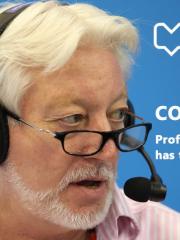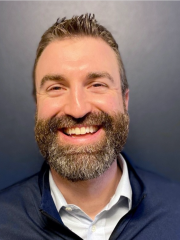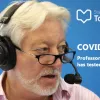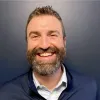Portrait Mobile, monitoring the unmonitored | ESAIC 2023
Desiree Chappell, Monty Mythen and Andrew Cumpstey sit down with Cory Stahl, Global Marketing Manager at GE HealthCare to talk about Portrait Mobile.
Show Notes
Transcript
Speakers
Desiree Chappell, Monty Mythen and Andrew Cumpstey sit down with Cory Stahl, Global Marketing Manager at GE Healthcare to talk about Portrait Mobile.
Top Med Talk.
Desiree Chappell: Well, hello and welcome to Top Med Talk. We´re at Euro anesthesia 2023 in Glasgow, Scotland, for the annual meeting of the European Society of Anesthesiology and Intensive Care. I´m Desiree Chappell, your host, and I´m joined by Monty Mythen, my co-host. Hello, Monty.
Monty Mythen: Hey, Desiree. Great to be here.
Desiree Chappell: It is! End of day two. Lots of amazing conversations
Monty Mythen: towards the end of day two.
Desiree Chappell: Oh, it's still going, actually. They go pretty late here.
Monty Mythen: They do, yeah.
Desiree Chappell: For this meeting, we're sticking around, I think. It doesn't close until like, 06:00.
Monty Mythen: And then it rolls straight into Pink Floyd.
Desiree Chappell: Is there another one today?
Monty Mythen: I don't know. There were people wandering around with T-shirts again. I don't know. Maybe it's just a lot of Pink Floyd fans around.
Desiree Chappell: There are, yeah. So apparently so where we are at the SCC, this exhibition center here in Glasgow, there's also an event venue where they've had Pink Floyd here the last couple of nights. So real treat. Joining us here this year is Andy Cumpstey to have some of those. Thank you so much for joining us, Andy.
Andy Cumpstey: Hi, Desiree. Thanks for having me.
Desiree Chappell: Yeah, taking the load off a little bit. We appreciate that. Helping us out here. What have you thought about the meeting so far?
Andy Cumpstey: It's been a fantastic today, hasn't it? Really great. Keep taking all the talks, but great buzz in the exhibition hall. Loads of friendly faces keep bumping into people to be recognized and chat from the corridors, but also loads of really cool new technologies to look at the stands and really interesting talks
Monty Mythen: And barista friend. Yeah.
Andy Cumpstey: Behind me
Monty Mythen: And a speech going on next to us. There's just a lot happening.
Desiree Chappell: It's lively. I mean, that's what it's going on. There are a lot of people here. Ultrasound technology that's right around the corner that they're exploring. There are all kinds of stuff. So, it's really a really great meeting. Well, one of the things that we love to do is highlight the work that our sponsors are doing for us, those folks that are keeping Top Med Talk alive. Free open access medical education for the world. Right, Monty? Top Med Talk, that's what we're about.
Monty Mythen: We've always been about trying to make sure that everything we do can be reached by the whole world. So, whether it's our podcasts and our conversations, like we're doing today, or it's the evidence based perioperative medicine conferences, although people pay to watch them virtually, etcetera, they can listen to them in the months to follow. Completely free open access because of the generous sponsorship of people like GE HealthCare.
Desiree Chappell: Yeah. So, with us today is Cory Stahl, the Global Marketing Manager Monitoring Solutions. Cory, thank you so much for sitting down with us.
Cory Stahl: Thanks, Desiree. Thanks, Monty. It's good to be here. Exciting times here at the booth and lots of traffic, lots of great discussions. So, it's wonderful to be at another Euro Anesthesia.
Desiree Chappell: Yeah.
Monty Mythen: I get the impression that however Euro anesthesia do it, they get the balance right, for the opportunity to engage with industry partners. So occasionally you go to conferences, and you think, actually that was a lot of effort to not have a lot of footfalls, whereas here it's been active a lot of the time. I mean, part of that's a tribute to all for putting on lots for them to see and the exciting way of presenting it. But it's also, well, big shout out to the meeting itself.
Andy Cumpstey: Yeah.
Cory Stahl: They do a wonderful job of organizing not only the congress for us to be able to come in and show what we're working on and developing, but also to get feedback to have these meaningful conversations. The lunch symposiums have been wonderful, a whole slate of academic presentations. So, it's really been a wonderful congress and we always appreciate the ability to be here as an industry partner.
Monty Mythen: Yeah.
Desiree Chappell: It seems like the booth has just been bebop. There are a ton of people around.
Cory Stahl: As we come out of a post pandemic era. Feels like everything is really back to normal. And it's great to see so many familiar faces.
Desiree Chappell: Yeah, for sure. Well, we were here last year during the introduction of Portrait Mobile, so I think that's one draw. You guys have a lot of things going on. It seems like a lot of different product solutions available for people to look at. Portrait Mobile was one of those. Let's talk a little bit more about that.
Andy Cumpstey: Yeah.
Cory Stahl: Portrait is certainly near and dear to my heart. There's a lot of conversations that have taken place in some of the scientific sessions here. Just talking about the need for continuous monitoring and the postoperative care pathway, right?
Cory Stahl: How do we detect deterioration earlier? And Portrait has really been designed to help with that, especially recognizing the importance of respiration rate monitoring as that early indication of a change in a patient's status.
Desiree Chappell: Yeah, and there's so many patients that are not being monitored right now.
Monty Mythen: That's so true.
Cory Stahl: It really is monitoring the unmonitored. Right. I mean, I think we're all familiar with the spot check or the Q four protocols that exist, but the reality is most patients are not continuously monitored and deterioration doesn't suddenly happen, it's suddenly detected. And so, we feel passionately that if we can help provide a technology that fits seamlessly into existing workflows and I think that's the key, it has to fit.
Cory Stahl: But if you can do that, you're really able to improve outcomes for patients, and that's what matters.
Monty Mythen: To remind us, ourselves of the context, here a patient coming in for, for example, elective major in-hospital surgery. They call that major orthopedic or major cancer bowel surgery or something. When they're in the operating room, they're literally being monitored every second. So, lots of their physiological variables are being monitored second by second and they're being man marked by a team of providers. They then transfer into the recovery area where they're still being looked at every second and minutes and the variables are being recorded on a frequent basis. Then in most places in the world irrespective of how well resourced that place is, places that we all work at, if they go back to the floor, they can then switch very dramatically to that. Maybe Q One to start with, as we call it, every hour. Then maybe quickly, if that looks okay, they transition to every two or four.
Desiree Chappell: Or eight
Monty Mythen: Or 8 hours.
Monty Mythen: That's a lot of time for bad stuff to happen. And that's one of our we talk about it frequently as one of our dirty little secrets. To be true, it's one of those things where we say shame on us. It's a terrible thing to have to admit that we've got all this amazing technology and this intensity of care, and then it suddenly falls off a cliff. And I think that's what you're trying to help us close that gap.
Cory Stahl: Yeah, I think that's one of the things that GE certainly recognized, right. Having conversations with industry leaders and recognizing where could technology play a role? And we've certainly seen limitations of technology in the past, right?
Cory Stahl: We've all seen where a hospital recognizes this and they take an ICU level monitor and they put it in the ward, and then it tends to alarm, like an ICU level monitor. So that doesn't work.
Desiree Chappell: Right.
Cory Stahl: You can't introduce an alarm burden where there aren't alarms today. And so recognizing that, having conversations, looking at how do we measure something that's going to be meaningful, how do we make sure that we have alarms that are relevant and actionable and really focusing on that is what we've really honed in on with Portrait Mobile.
Desiree Chappell: Yeah, it seems like, I mean, we've talked a lot about Portrait Mobile over the last, really just a year and learning about the technology, because I think that there are a lot of questions. Anytime you do, like you said, integrate new technology into a new space, there will be. It sounds like you guys were very thoughtful about this particular solution for monitoring patients.
Cory Stahl: Yeah, there was a lot of design considerations that went into it, and it really started with observation, right? What are the current practices? Listening to others. What are the pain points of not only providers, but also patients? And so, there are a couple of things that kind of bubbled to the surface. One of the challenges was wires, right? If you have a patient that's in the ward, usually that early ambulation is key, right? Whether it's an ERAS protocol or giving them the ability to visit with loved ones that might be there with them, and the wires tend to get in the way. And so, one of the first things we looked at was, okay, we want this to be wireless, but you can't trade a cable management issue for a battery management issue. So how do we have smart battery management workflows that don't require frequent changes from the clinical staff that provide a wireless connection that's as reliable as a wired connection? So, we started looking at some of those technology pieces from an implementation and then at the same time we're looking at the clinical needs. And the evidence is overwhelming with the need for respiration rate.
Cory Stahl: But historically there have been challenges with having an accurate respiration rate that didn't come with some of these tradeoffs.
Desiree Chappell: Yeah, I mean, if you go and look at a patient on the ward that's having any kind of telemetry or continuous pulse oximetry, things like that, there are wires everywhere. Most of the time those are coming undone because they need to get up and go to the next test. It's very burdensome and cumbersome for the patients to do really anything other than just lay there.
Cory Stahl: Yeah, you bring up a good point. You mentioned telemetry, and I know we're in Europe where cardiac telemetry isn't at the level that you see in, say, the United States, but even in the US, it's a major issue where they want continuous monitoring, but they don't have the appropriate tools. So, okay, let's put them on something, anything will work. And so that often ends up being cardiac ECG for even your non cardiac patients.
Desiree Chappell: Right, and that really is not really a solution to the problem. We're just make shifting hoping that it's going to be something and then people actually stop adopting and stop using it because it's not the right solution for what we're doing. Talk to us a little bit more about how Portrait Mobile is that good solution for some of those problems.
Cory Stahl: One of the things that is a cornerstone with this new technology is really the respiration rate technology. We call it dual vector respiration rate, or RRdv on some of our literature. But we looked at what works and some of the technologies and what doesn't in many of the approaches. Many of your listeners will be all too familiar with some of the challenges and pains of impedance-based technologies. And yet if you do impedance, you could theoretically be wireless. And so, we worked with our scientists and with industry partners, and we developed a whole new parameter as part of the Portrait Mobile program with this dual vector respiration rate technology. And so really excited about it. We have something that's quite accurate. We have some studies out there showing more than 99% accuracy compared to Capnography. So, you've got the accuracy, but we're able to do that in a wireless package that frees that patient to ambulate right. And so, when you start to combine these and, you know, we're monitoring something that will detect deterioration earlier, we're providing continuous monitoring of that. And yet the patient isn't tethered to a bed. The patient's comfortable. And so being able to find that balance was really key as part of the program criteria.
Desiree Chappell: This is like sticky pads, right, that kind of go on the chest.
Cory Stahl: Yeah, that's right. Essentially three electrodes. There's one in the upper right chest, one that goes under the left armpit, and then one on the left abdomen. And it lets you look at both a thoracic and an abdominal channel that we can measure simultaneously. So, we've all seen patients roll over. Some are side sleepers, some are on their back, right? Some belly breathers, some chest. The combination of the dual vectors allows us to have an accurate respiration rate even if one of the vectors was compromised.
Desiree Chappell: That makes sense. Andy, this might be newer technology.
Andy Cumpstey: What happens to that data? So, Desiree mentioned burdensome cumbersome words and you mentioned about intensive care systems not being appropriate quite rightly, because of the alarms level, but that's a huge amount of data you're getting off these patients, and its continuous respiration rates. Where does that data go and how is it then actioned by the team on the ward? What's the pathway?
Cory Stahl: Yeah, that's a great question. Having access to that data in real time is going to be important for those clinicians. And so, when we designed Portrait Mobile, we really looked at it as an ecosystem. So, you do have a central viewer, so you could deploy that at a nurse's station as an example and see a multi patient view with everybody on your ward. As an example, you can drill in, and you can see a single patient's data in real time. You'll get an SPO2 waveform, respiration waveform, as well as some trending. Right. We know sometimes knowing where your patient's been, where they're going, right. That trend is super valuable. So, you have all that available at the central station, as well as a small mobile monitor that's in the patient's room. But then we also used industry standards like IHE and HL7 so that you can pipe that into your hospital record system so that you could send that to secondary alert notification systems if you choose. So, we really want to make sure that the system is interoperable with other investments that hospitals have already made.
Andy Cumpstey: Does that data inter wrap with other tools in the GE portfolio? Can it be linked with other technologies you're offering?
Cory Stahl: Yeah, we do have other technologies that can consume that data. We've got some systems that would pull in disparate data sources in order to do analysis or protocol compliance. Our mural product is one that comes to mind. I'd love to sell you everything that's GE, but let's be realistic. There are other solutions. And I know that many of our customers have already made investments in other vendors technologies or may have something that is homegrown, and we want to be able to support that as well. Right. We want to make it easy to adopt and get the relevant information, whether that's staying in our ecosystem or whether it's piping to another one, either works.
Andy Cumpstey: And you mentioned you've been working with patients and clinicians to design this kit. What's the feedback from patients about this device?
Cory Stahl: We've had some really fun feedback from patients. I'm a marketer, so I love hearing this in use.
Andy Cumpstey: Patient words are powerful long. If you hear in their words, it's different to what we might say around the table.
Cory Stahl: It absolutely is. When I have patient feedback that says, oh, I actually forgot I'm wearing it, that is music to my ears, because that means that our designers did their job right. We made it comfortable; we made it disappear so that it doesn't feel burdensome, and that means that they're able to recover more effectively and get back to their life, right?
Andy Cumpstey: And what happens when it fails? I mean, do these pads ever come off? Do they get hot and sweaty?
Desiree Chappell: Do they come limitations for the use?
Andy Cumpstey: Yeah.
Cory Stahl: So, limitations. Talk about battery life. Battery life is something that we paid particular attention to. The batteries have about a 30-hour life, and the intended workflow is once a day. Right. So, you do a battery change, whether it's a clinician or a technician in the morning. But we use universal batteries, so we've been talking a lot about RRdv technology. We also have a wireless patient worn SPO2 that also gives you the pulse rate, and it's the same reusable battery. It's a rechargeable battery that works on both the SPO2 and the respiratory. So, some of that.
Desiree Chappell: I was wearing that around yesterday.
Cory Stahl: I think I saw it
Desiree Chappell: It was very cool monitoring myself and it was not cumbersome at all. No big deal.
Cory Stahl: Yeah. So, we focused on trying to make it easy for the workflows. But it is a battery-based technology, right? So, we wanted to minimize the environmental footprint. That's why we went with the lithium based rechargeable platform. But you are going to have to change batteries once a day. But again, I'm expecting that our clinicians are going to be in there anyways. And so, things like plug and play, right? There's no repairing, there's no reconnecting some sort of Bluetooth connectivity. In fact, the wireless connection is not Bluetooth based, it's actually a medical body area network that we created.
Andy Cumpstey: Say that again? What does that mean?
Cory Stahl: Yeah, so you see a lot of Bluetooth based communications. I'm sure you've seen some of the papers with dropout and packet loss associated with Bluetooth. That was one of the things we recognized as a potential limitation with a wireless technology. And so, we're actually creating a medical body area network. It's a recognized protocol and we have a ByndrTM communication protocol that rides in that spectrum, basically ensuring that any data that comes off a sensor is going to be received by the monitor. And so we designed for worst case, right? That's what you have to do. And that means an obese patient that got up without telling the nurse, they walk into the toilet, they slip, they fall, they're on the sensor, the door shut. I still need that wireless information to get back to the monitor. So, we'll actually send it up to nine different times. So, three different tries on three different frequencies to make sure that those packets do get to where they need to be. So little things like that to make sure that it's robust and reliable. But again, it does have range.
Desiree Chappell: They can't be like outside taking a walk.
Cory Stahl: There are some range limitations that you would expect from any wireless technology. If you're in the room, that patient's free to move about without the patient monitor. If they leave the room, then you want to take the small mobile monitor with them.
Andy Cumpstey: Right.
Cory Stahl: We've got some safety mechanisms built in to alert if somebody went too far out of range, but again, trying to free up these patients and allowing the protocol of care to go through unencumbered.
Monty Mythen: We've touched on some of the challenges in this space and it sounds you've addressed, or are addressing many of them. In the UK, for example, where we've adopted a national early warning score, which seems to have gone pretty well from the point of view of detecting deteriorating patients. A number of variables were chosen to inform that score. I think predominantly based around what was available as opposed to what was going to be the best to achieve the detection of the deteriorating patient. Now, the reason for my ramble is when we're going down the route of these potential solutions to the challenge, we're sometimes trying to match that national early warning score, which draws us into trying to measure all of those variables. And usually there's a tradeoff where you can't do all of them. You have to give up something, whether it's blood pressure or respiratory rates or conscious level. It's hard to get all of the components. Can yours deliver all of the components? Which is not a criticism if it can't. My question is your experience is that you don't need all the variables to detect the deteriorating patient.
Cory Stahl: This is intended not to replace your spot check vital signs. This is a compound. So, we've recognized that respiration rate, as well as SPO2 and pulse rate are kind of the three key variables that you want to have continuous. Now, again, that's intended to work in conjunction with your spot check protocol. So, we'll have the rest, the SPO2, the pulse rate continuous. And then on your protocol, whether it's your 1 hour or whether it's your four hour or your eight, the clinician would still take those additional parameters and document them as part of a muse or amuse and calculate your score off the full set.
Monty Mythen: You'd hope that if the patient was deteriorating with the variables that are immediately available, we would respond by a clinician going to the bedside, doing their standard vitals evaluation. And if that triggers an early warning score, then we'd be sending to the next team, which would come with more connected kits and more maybe minimally invasive, but more wired kits and step it all up until we got all the way through to ICU level monitoring.
Cory Stahl: Yeah, absolutely. And the hope would be that you don't need that ICU level monitoring because you can intervene early.
Desiree Chappell: Right.
Cory Stahl: If you catch a patient´s respiration rate taking up and you are worried about sepsis, that's 30 minutes after your last spot check. Yes, that's still likely hours earlier than you would have caught it in your next spot check. And so being able to provide some of those trends, being able to provide some of those alerts, we really want to empower the nurses, the clinicians, to respond early and we want to give them the objective data. In practice, how often do you have an experienced nurse say, I just got this gut feeling something's not right? Well, now that you have these objective measurements, you take the subjectivity out of it and they can say, oh yes, this patient's respiration is X, or we saw their pulse rate increase. Here's what might be happening.
Desiree Chappell: Well, it gives the nurse now the objective data to say, my gut feeling is right, there is something going on with this, we need to check this out. Let's go down this path.
Monty Mythen: And the final challenge, which you've alluded to is the information overload, the alarm fatigue, the potential for wanting to switch things off because they keep going off. How are we going down on that route?
Cory Stahl: Yeah, the alarming strategy is going to be key to the adoption of any new technology, again, especially in a ward where you traditionally don't have alarms. And so, there's a couple of pillars that I think of when I'm thinking about how you design alarms. First, you need sensors that are going to get accurate information, right. Garbage in, garbage out, type of thing. So, we want accurate information coming in. You want to have algorithms that are designed for the type of environment they're going to be used in. And the word that means you need to be motion tolerant. That means you might need to dynamically adjust if a patient's moving around, if they're getting up and walking, right? So, having some of these things built into the algorithm and then we combine that with the flexibility of alarm delays and some different threshold settings to really tailor a unit's alarm settings so that it's truly actionable, right?
We want something that's sustained. We don't want a transient event to cause an alarm if it's going to resolve. And so by looking at those variables together and also being able to do some analysis on the number of alarms and create an alarm report, you can really start to dial in how many alarms you might expect as a user if I changed my SPO2 from 90 to 89, or what if I said instead of a 15S delay, I put in a 30 S delay, right?
What is the clinical impact of that? Is it going to change my behavior on a response team? So, looking at that in total, we're really able to reduce the alarm burden, not just silence it, but you don't have them to begin with.
Andy Cumpstey: And again, we were talking in a previous talk, Desiree, about the reliance on It systems and problems that we may have all had in our institutions. But how happens this data, if the power goes down, if the system gets hacked or whatever the disaster is, all this data is electronic and then is it gone or is it.
Cory Stahl: That is a great question and a couple of things that I hear asked frequently. One is, is it secure from a cyber perspective? And the answer is absolutely yes. We're using the latest cyber standards. And I think gone are the days where cyber was added as an afterthought.
This was purpose built from the ground up with cyber in mind. So, it's fundamentally a different approach. So that's one piece of it. The other thing is we're writing on a hospital's Wi-Fi, so you don't have to install expensive infrastructure in order to get that information. But we know that with Wi-Fi, maybe there's an IT outage, maybe a patient walks out of range, maybe they go across the street for a smoke. We see all kinds of crazy things, right? No, but you want to make sure that you still have a complete patient record. And so, the mobile monitor continues to A, record the information, B do the analysis and C would alarm if needed, even if it's out of range, if there was a power outage or if there was a Wi-Fi outage.
So, we've got some safety redundancy built into the system to help combat some of those edge cases that could happen.
Andy Cumpstey: And then I guess one follow up question just from that. So, if the data kept in a nice secure place and it's accessible, does that mean it's then available for quality improvement for research tools? All our data is available for that, but trying to access it with the governance systems and things can be politically challenging in occasions.
Cory Stahl: Yeah. So, if you have a data lake that you're using for research, you can absolutely pipe the data directly into that. We do have research tools as part of the system. We know that some of our advanced users, like yourself, may want to look at things a little differently. So, we do have some tools around that to support research use cases as well. And again, for us, we don't want it to be a proprietary system with the data, right? This is your patient's data. We want to measure it accurately, we want to alert you if there's a condition that you want alerted for, but otherwise the data is yours. And so, to send it to another system is part of the design.
Desiree Chappell: Cory, I have one last question for you. It is really important to have this new technology coming through and figuring out how we do our jobs more efficiently and how we get better information.
I feel like one of the limitations is that someone develops something new. I think you've been very thoughtful; the company has been very thoughtful about how they've done it. But when you go to deploy it, the education, the support for the providers on the ground who are actually going to have to use it.
I've been in a lot of situations where someone has given me a new tool, piece of equipment, whatever, and they're like, go for it. What kind of support are you giving your clinicians whenever they go to use these solutions?
Cory Stahl: Yeah, we certainly have clinical education as part of that. We want the users to know how to use it, right?
Desiree Chappell: Yeah,
Cory Stahl: It certainly helps us. It's in GE's best interest if a technology is adopted. And to that end, we also design with usability in mind. So yesterday you probably saw when you were wearing the sensor in the pairing process, we've taken cues from the cell phone industry. So, you've got near field communication, right? Kind of that tap to pair. We have nice visual instructions when you create a pairing, showing exactly what to do. And so, we want to make it easy enough that I could drop it off and walk away, so to speak, and you could figure it out. But we also have the education to make sure that everyone feels comfortable with that.
Desiree Chappell: Yeah, it really was picking up the monitor, sticking it on and there you go. Easier than an iPhone, actually, which is hard to believe, or cell phone, I should say. Well, Cory, this has been an enlightening discussion. Thank you so much for sitting down with us to have a chat about portrait mobile and the solutions that you guys are providing for patient monitoring and monitoring the unmonitored. I think that's a great way.
Cory Stahl: Thank you. And thank you for all that you do for the industry.
Desiree Chappell: Yeah. All right, gentlemen, thank you very much. We appreciate it and thank you for listening to Top Med Talk here, at Euro anesthesia 2023. If you like this conversation, you can find many more at topmedtalk.com. You can find us on social media: Twitter, LinkedIn, Facebook. We are there. Thanks so much.
Top Med Talk. Thanks for downloading Top Med Talk. Don't forget to subscribe via your podcatcher. Don't forget to check us out on social media. We're on Twitter, Facebook, LinkedIn and YouTube. And also, don't forget, Top Med Talk is the broadcasting arm of EBPOM, evidence based perioperative medicine. We'd love you to find out more about that. If you check out ebpom.org, you can find low prices on some of the conferences we're organizing around the world. Many of them are virtual and don't even involve you leaving your own home. Check out ebpom.org now.

Desiree Chappell
MOM, CRNA and Host of The Roundtable Blog
Board of Directors, American Society of Enhanced Recovery (ASER). A passionate ambassador of Enhanced Recovery and Perioperative Care. Desiree is the creator of the popular Roundtable perioperative care blog: http://periopcareblog.com/

Prof. Monty Mythen
Co Founder and Editor In Chief of TopMedTalk
Monty is the Smiths Medical Professor of Anaesthesia and Critical Care at University College London and Adjunct Professor, Department of Anaesthesiology, Duke University, USA. Monty is also the founding Director of Evidence Based Perioperative Medicine International.

Andy Cumpstey
Andrew Cumpstey trained in general medicine, anaesthesia and intensive care medicine in
Cambridge, Oxford and Southampton. He completed his PhD at the University of Southampton, exploring the effect oxygen therapy has on oxidative stress in major surgery and critical illness.
His research interests include improving clinical outcomes from major surgery and intensive care, translational clinical studies in oxygen physiology and therapy, and physiological changes in extreme environments.
He works clinically in the Southampton region looking after patients having all forms of major surgery or needing intensive care admission. Outside of the hospital, he regularly provides medical, safety and logistical support to expeditions visiting remote mountain and polar regions.

Cory Stahl
Global Marketing Manager at GE HealthCare
Lead global marketing activities to support customer installed base and launch new product introductions for GE Healthcare's patient monitoring business. Collaborate with product management, region marketing, and sales leaders to identify and prioritize market needs and opportunities.














